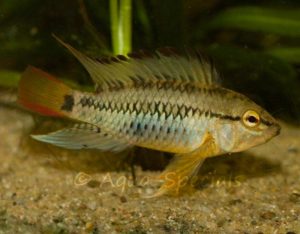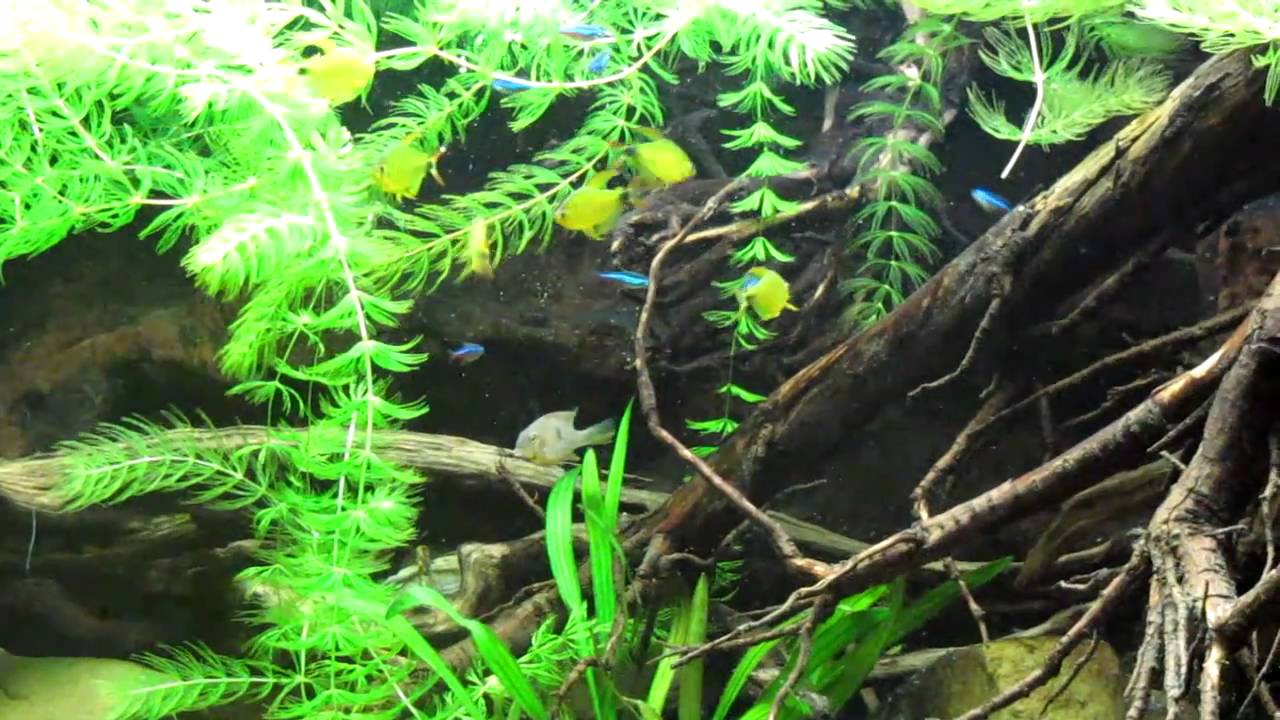Hyphessobrycon heliacus – Kitty Tetra
The scientific name for this fish species is Hyphessobrycon heliacus. In English, they are also known as Kitty Tetras. The species was first described by Moreira, Landim & Costa in 2002 . The fish belong to the family Acestrorhamphidae , also known as the American Tetras.
The genus name, Hyphessobrycon, is of somewhat obscure origin. The second part is derived from the Greek βρύκω (bryko), meaning “to bite” . The first part, hyphesson, is possibly an error for υπελάσσων (hypelasson), meaning “slightly smaller” . Often the translation “Little Biter” is given to this name. The species name, heliacus, is derived from the Greek “heliakos,” meaning “sunny,” referring to the bright golden color of the fish when alive .
Description
The Kitty Tetra(Hyphessobrycon heliacus) has a somewhat higher and laterally flattened body, widest at the dorsal fin. The head is slightly convex. In the water, they look golden yellow, with dark spots scattered over the body and fins. A prominent, large, dark spot is on the base of the tail. The fins are orange to reddish. They grow to about 2.8 centimeters long (standard length). The total length then comes out to a maximum of about 3.5 centimeters.
Males and females are different. Males have longer, thread-like fins (especially the dorsal, anal and ventral fins) and are more brightly colored than the females. The anal fin of an adult male does not have a distinct tip, while females and juvenile fish do. Young Kitty Tetras are less brightly colored than adult fish.
Kitty Tetras are peaceful fish that prefer to swim in groups. They are not aggressive and usually swim in the middle of the aqu arium. They are a little shy and like to hide among plants. They live about 4 years in an aquarium, but how old they get in the wild is unknown.

Biotope
Hyphessobrycon heliacus is found in the wild in Brazil. The fish live in the upper reaches of the Rio Tapajós basin, specifically in the Rio Teles Pires and its tributaries in the state of Mato Grosso. They are river fish that live in the slow-flowing, marginal parts of streams with a muddy bottom and lots of underwater plants. The banks of these waters are covered with vegetation, including aquatic and marsh plants, decaying organic matter and roots. The bottom consists of mud.
The fish live in a tropical climate with a water temperature between 23°C and 28°C.
Diet
In the wild, Hyphessobrycon heliacus is an omnivore that feeds on small insects, crustaceans and plant material. In an aquarium, they accept a variety of foods, including high-quality tropical fish food in the form of flakes or micropellets, supplemented with live or frozen foods such as water fleas, mosquito larvae and artemia. A varied diet ensures vibrant colors and optimal health. It is important not to overfeed the fish to avoid water pollution; several small portions a day are better than one large meal.
The Aquarium
A school of at least 10 Hyphessobrycon heliacus requires an aquarium of at least 80 liters, with a length of 60 centimeters. A larger school requires a significantly larger aquarium, with the overall length and volume having to be adjusted for the number of fish. The aquarium should be rich in planting, with both dense vegetation and open swimming areas. Use a fine sand substrate, as this best approximates the natural habitat. Floating plants, such as Salvinia natans, can be added to create a subdued light, as in their natural habitat. Avoid sharp rocks or decorations that could injure the fish.
The ideal water values are a temperature between 23°C and 28°C, a pH between 5.5 and 7, and a GH between 8 and 15 . Regular water changes of 20-30% per month are essential to maintain water quality.
Suitable co-inhabitants are other small, peaceful fish species that tolerate similar water parameters, such as certain species of Corydoras armored catfish , small tetras and small, peaceful carp salmon. Avoid larger, aggressive fish or crustaceans, as Hyphessobrycon heliacus may become prey.
Breeding Hyphessobrycon heliacus
The breeding of Hyphessobrycon heliacus in captivity is possible. However, not much is known about it yet.
Conclusion
Hyphessobrycon heliacus is a small, peaceful and relatively easy to keep fish for advanced beginners. A well-designed aquarium with adequate planting, a fine sand substrate and suitable water parameters are essential for their well-being. A school of at least ten specimens is recommended to avoid stress . Although they are not particularly demanding, successful breeding does require a specific setup and attention to detail.
A notable feature is the pronounced sexual dimorphism in males, with their longer fins and more vivid colors. Their shy behavior and preference for dense vegetation in an aquarium is also an important observation. In general, keeping this species is a positive experience, provided basic needs are met.
Video
Author
John de Lange
Copyright images
F. Ingemann Hansen – Akvariefotografen.com












